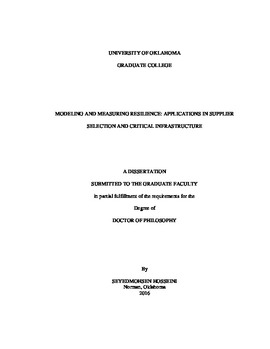| dc.description.abstract | Nowadays, infrastructure systems such as transportation, telecommunications, water supply, and electrical grids, are considerably facing the exposure of disruptive events such as natural disasters, manmade accidents, malevolent attacks, and common failures due to their size, complexity, and interconnectedness nature. For example fragile design of supply chain infrastructure might collapses because the consequences of a failure can propagate easily through the layers of supply chains, especially for large interconnected networks. Previously, owners and operators of infrastructure systems focused to design cost-efficient, competitive and sustainable ones; however the need for design of resilient infrastructure systems is inevitable.
Infrastructure systems must be designed in such a way so that they are resistant enough to withstand and recover quickly from disruptions. The consequences of disruptive events on infrastructures ranging from energy systems (e.g., electrical power network, natural gas pipeline) to transportation systems (e.g., food supply chain, public transportation) cannot only impacted on individuals, but also on communities, governments and economics.
The goal of this dissertation is to (i) identify the resilience capacities of infrastructure systems; in particular inland waterway ports, and supply chain systems, (ii) quantify and analyze the resilience value of critical infrastructure systems (CIs), (iii) improve the resilience of CIs by simulating different disruptive scenarios, and (iv) recommend managerial implications to help owners and operators of CIs for timely response, preparedness, and quick recovery against disruptive events.
This research first identifies the resilience capacity of CIs, in particular, inland waterway, supply chain and electrical power plant. The resilience capacity of CIs is modeled in terms of their absorptive capacity, adaptive capacity and restorative capacity. A new resilience metric is developed to quantify the resilience of CIs. The metric captures the causal relationship among the characteristics of CIs and characteristics of disruptive events including intensity and detection of disruption likelihood of disruptive events. The proposed resilience metric is generic, meaning that can be applied across variety of CIs. The proposed metric measures the system resilience as the sum of degree of achieving successful mitigation and contingency strategies. The resilience metric accounts for subjectivity aspect of disruptive events (e.g., late disruption detection, very intense disruption, etc.). Additionally, the proposed resilience metric is capable of modeling multiple disruptive events occurring simultaneously.
This research study further explores how to model the resilience of CIs using graphical probabilistic approach, known as Bayesian Networks (BN). BN model is developed to not only quantify the resilience of CIs but also to predict the behavior of CIs against different disruptive scenarios using special case of inference analysis called forward propagation analysis (FPA), and improvement scenarios on resilience of CIs are examined through backward propagation analysis (BPA), a unique features of BN that cannot be implemented by any other methods such as classical regression analysis, optimization, etc.
Of interest in this work are inland waterway ports, suppliers and electrical power plant. Examples of CIs are inland waterway ports, which are critical elements of global supply chain as well as civil infrastructure. They facilitate a cost-effective flow of roughly $150 billion worth of freights annually across different industries and locations. Stoppage of inland waterway ports can poses huge disruption costs to the nation’s economic. Hence, a series of questions arise in the context of resilience of inland waterway ports.
How the resilience of inland waterway ports can be modeled and quantified? How to simulate impact of potential disruptive events on the resilience of inland waterway ports? What are the factors contributing to the resilience capacity of inland waterway ports? How the resilience of inland waterway can be improved? | en_US |
